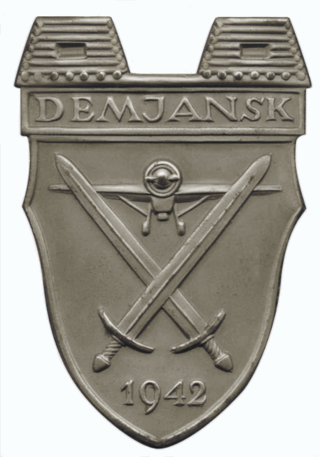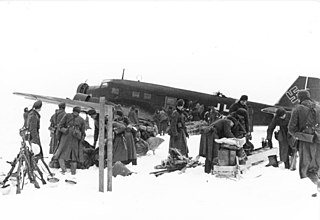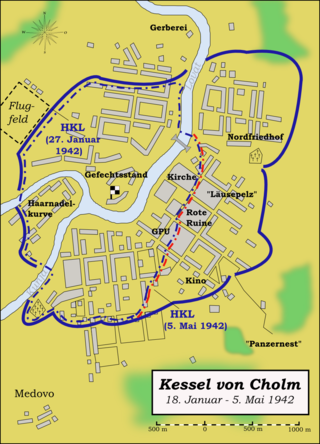Related Research Articles

The Battle of Stalingrad was a major battle on the Eastern Front of World War II where Nazi Germany and its allies unsuccessfully fought the Soviet Union for control of the city of Stalingrad in Southern Russia. The battle was marked by fierce close-quarters combat and direct assaults on civilians in air raids, with the battle epitomizing urban warfare. The Battle of Stalingrad was the deadliest battle to take place during the Second World War. Today, the Battle of Stalingrad is universally regarded as the turning point in the European theatre of war, as it forced the Oberkommando der Wehrmacht to withdraw considerable military forces from other areas in occupied Europe to replace German losses on the Eastern Front, ending with the rout of the six field armies of Army Group B, including the destruction of Nazi Germany's 6th Army and an entire corps of its 4th Panzer Army. The victory at Stalingrad energized the Red Army and shifted the balance of power in the favour of the Soviets.

Wolfram Karl Ludwig Moritz Hermann Freiherr von Richthofen was a German World War I flying ace who rose to the rank of Generalfeldmarschall in the Luftwaffe during World War II.

Case Blue was the German Armed Forces' plan for the 1942 strategic summer offensive in southern Russia between 28 June and 24 November 1942, during World War II. The objective was to capture the oil fields of Baku, Grozny and Maikop for two purposes: to enable the Germans to re-supply their low fuel stock and also to deny their use to the Soviet Union, thereby bringing about the complete collapse of the Soviet war effort.

The hedgehog defence is a military tactic in which a defending force creates multiple mutually supporting strongpoints ("hedgehogs") in a defence in depth, designed to sap the strength and break the momentum of an attack. The hedgehogs are designed to be both strong in defence, and thus expensive for an attacker to assault, and capable of mounting counterattacks. The intention is that the attacker will instead bypass them. This will divide his front, expose his forward units to enfilading fire as they pass between hedgehogs followed by attack from the rear when they have passed them, and leave his rear echelons and lines of communication open to counterattack.

Demyansk Shield was a World War II German military decoration awarded to Wehrmacht personnel who fought in the Demyansk pocket on the Eastern Front in the early months of 1942. The pocket of German troops had been encircled and cut off by the Red Army around Demyansk (Demjansk), south of Leningrad, and was successfully defended with the aid of an airbridge. The shield was instituted on 25 April 1943 by Adolf Hitler and was not bestowed after 1 July 1944.

The Kuban Shield was a World War II military decoration of Nazi Germany. It was awarded to Wehrmacht forces who fought at the Kuban bridgehead in the Soviet Union from February 1943 until it was abandoned in October 1943. The award was instituted on 21 September 1943.

The Demyansk Pocket was the name given to the pocket of German troops encircled by the Red Army around Demyansk, south of Leningrad, during World War II's Eastern Front. The pocket existed mainly from 8 February to 21 April 1942.

The Battle of the Caucasus is a name given to a series of Axis and Soviet operations in the Caucasus area on the Eastern Front of World War II. On 25 July 1942, German troops captured Rostov-on-Don, Russia, opening the Caucasus region of the southern Soviet Union, and the oil fields beyond at Maikop, Grozny, and ultimately Baku, to the Germans. Two days prior, Adolf Hitler issued a directive to launch such an operation into the Caucasus region, to be named Operation Edelweiß. German forces were compelled to withdraw from the area that winter as Operation Little Saturn threatened to cut them off.

An airlift is the organized delivery of supplies or personnel primarily via military transport aircraft.

Stalingrad, a Soviet city and industrial centre on the river Volga, was bombed heavily by the Luftwaffe during the Battle of Stalingrad in World War II. German land forces comprising the 6th Army had advanced to the suburbs of Stalingrad by August 1942. The city was firebombed with 1,000 tons of high explosives and incendiaries in 1,600 sorties on 23 August. The destruction was monumental and complete, turning Stalingrad into a sea of fire and killing thousands of civilians and soldiers. Further fire-attacks were mounted against the ruined city for the next two days, enveloping it in dense volcano-like black smoke clouds that stretched 3.5 kilometers into the sky. At least 90% of the housing stock was obliterated.

The German Seventeenth Army was a field army of Nazi Germany during World War II.
Martin Fiebig was a German Luftwaffe general who commanded several air corps and equivalent-sized formations during World War II. He was a recipient of the Knight's Cross of the Iron Cross with Oak Leaves.

The 369th (Croatian) Reinforced Infantry Regiment was a regiment of the German Army raised to fight on the Eastern Front during World War II. The regiment was formed in July 1941 by Croatian volunteers from the Independent State of Croatia (NDH), including a Bosnian Muslim battalion. It was commonly referred to as the Croatian Legion. The troops swore a joint oath of allegiance to the Führer, the Poglavnik, the German Reich and the NDH. The unit was sent to the Russian front where it was attached to the 100th Jäger Division. It was the only non-German unit to participate in the battle of Stalingrad as part of the 6th Army, where it was virtually destroyed. On 31 January 1943, the 800 surviving Croatian legionaries, led by their commander Marko Mesić, surrendered to the Red Army.
The Tatsinskaya Airfield was the main airfield used by the German Wehrmacht during the Battle of Stalingrad to supply the encircled 6th Army from outside.

The Berlin Blockade was one of the first major international crises of the Cold War. During the multinational occupation of post–World War II Germany, the Soviet Union blocked the Western Allies' railway, road, and canal access to the sectors of Berlin under Western control. The Soviets offered to drop the blockade if the Western Allies withdrew the newly introduced Deutsche Mark from West Berlin.

Hans-Georg von Seidel was a German military leader who served in the German Army during World War I and in the Luftwaffe during World War II. Seidel was promoted to the rank of General der Flieger.

The Kholm Pocket was the name given for the encirclement of German troops by the Red Army around Kholm, south of Leningrad, in World War II's the Eastern Front, from 23 January 1942 to 5 May 1942.

The Kuban Bridgehead, also known as the "Goth's head position", was a German military position on the Taman Peninsula, Russia, between the Sea of Azov and the Black Sea. Existing from January to October 1943, the bridgehead formed after the Germans were pushed out of the Caucasus. The heavily fortified position was intended as a staging area for the Wehrmacht which was to be used to renew attacks towards the oil wells of the Caucasus. Axis positions in the bridgehead were repeatedly subjected to large Soviet offensives, but none ever comprehensively broke the Axis defensive lines. The bridgehead was abandoned when the Red Army breached the Panther–Wotan line, forcing an evacuation of the German forces across the Kerch Strait to Crimea.
References
- ↑ House of Commons Hansard Written Answers for 9 Mar 1999 (pt 7) " Mr. Doug Henderson: The reduction in the number of RAF Tristar Airbridge flights to the Falkland Islands by one flight per calendar month was one of a range of efficiency proposals identified by the Strategic Defence Review. It represents a rationalisation of the use of Tristar aircraft, following technical improvements that allow them to carry an increased payload, rather than representing any significant reduction to the overall capacity of the Airbridge. Final arrangements for the implementation of this measure are still under consideration."
- ↑ Hayward, Joel S. A. (1998). Stopped at Stalingrad: the Luftwaffe and Hitler's defeat in the east, 1942-1943. University Press of Kansas.
- 1 2 "Dokumenti koji pokazuju kako je Armija BiH od Zagreba grozničavo tražila pomoć za Bihać". Jabuka.tv (in Croatian). 2019-08-11. Retrieved 2023-05-17.